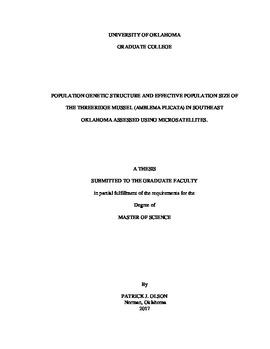| dc.description.abstract | A myriad of anthropogenic factors have led to substantial declines in North America’s freshwater mussel populations over the last century. A greater understanding of mussel dispersal abilities, genetic structure, and effective population sizes is imperative to improve conservation strategies. This study used nine microsatellite loci to investigate the genetic structure among mussel beds and estimate effective population sizes of Amblema plicata in beds in the Little River in southeast Oklahoma. I genotyped a total of 270 individuals from nine mussel beds distributed throughout a large extent (156 km) of the Little River. Currently, low flow conditions associated with drought, rather than impoundments, is likely the major driver of genetic structuring in the Little River. Genetic structuring was present within the Little River, with three upstream sites forming a distinct genetic cluster from six sites downstream. Years with low flow due to drought likely decreases, or blocks, gene flow between mussels beds in the upper Little River and beds in the lower Little River. Gene flow among beds in the lower Little River may not be impacted due to the higher flows in the lower part of the river. Gene flow in A. plicata can occur through the movement of host fish, sperm dispersal, larval thread dispersal, and/or juvenile drift. Estimates of effective population sizes (Ne) of large mussel beds were low compared to the total abundance (N) of A. plicata in each large bed with an average Ne/N ratio of 6.4%. Information on the genetic structure and estimates of effective population sizes of mussel beds can provide useful information on the spatial scale at which conservation plans should focus and the population sizes that should be sustained through relocation and restocking programs. | en_US |
